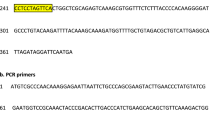Abstract
Fusarium wilt of chickpea, caused by Fusarium oxysporum f. sp. ciceris (Foc) is one of the most important fungal diseases worldwide. The detection of the pathogen at reasonable time period is of great importance, which requires rapid and sensitive detection methods. The intraspecific divergence sequences found in the intergenic spacer region (IGS) were selected and utilized with the aim to develop a molecular marker specifically to identify the Foc. A marker set, ISR52 F1 and R1 developed, was tested for their specificity as well as sensitivity using conventional as well as real-time polymerase chain reaction (PCR). The specificity of the marker was tested against Foc, other Fusarium species which are closely related to Foc as well as with artificially infected host plant samples. The detection limits of conventional PCR assay was up to 100 pg of infected plant DNA. It proved possible to amplify the IGS region in different portion of a Foc infected host plant by this PCR method. Furthermore, the real-time assay showed more sensitivity and was able to detect the pathogen in infected chickpea plant samples at the DNA concentration of 5 pg. A single melting peak obtained at 87.5°C showed the specificity of the marker towards Foc. Thus, real-time PCR assay proved their potentiality for same-day diagnosis of fungal infection and can be used as a rapid and effective procedure for routine detection and identification of Foc in chickpea samples.
Similar content being viewed by others
Abbreviations
- Foc :
-
Fusarium oxysporum f. sp. ciceris
- IGS:
-
intergenic spacer region
- PCR:
-
polymerase chain reaction
- qPCR:
-
quantitative PCR
References
Altschul S.F., Gish W., Miller W., Myers E.W. & Lipman D.J. 1990. Basic local alignment search tool. J. Mol. Biol. 215: 403–410.
Appel D.J. & Gordon T.R. 1996. Relationships among pathogenic and nonpathogenic isolates of Fusarium oxysporum based on the partial sequence of the intergenic spacer region of the ribosomal DNA. Mol. Plant Microbe Interact. 9: 125–138.
Benson D.A., Cavanaugh M., Clark K., Karsch-Mizrachi I., Lipman D.J., Ostell J. & Sayers E.W. 2013. GenBank. Nucleic Acids Res. 41: D36–D42.
Dubey S.C. & Singh S.R. 2008. Virulence analysis and oligonu-cleotide fingerprinting to detect diversity among Indian isolates of Fusarium oxysporum f. sp. ciceris causing chickpea wilt. Mycopathologia 165: 389–406.
Dubey S.C., Singh S.R. & Singh B. 2010. Morphological and pathogenic variability of Indian isolates of Fusarium oxyspo-rum f. sp. ciceris causing chickpea wilt. Arch. Phytopathol. Plant Protect. 43: 174–189.
Hall T.A. 1999. BioEdit: a user-friendly biological sequence alignment editor and analysis program for Windows 95/98/NT. Nucleic Acids Symposium Series 41: 95–98.
Haware M.P. & Nene Y.L. 1980. Influence of wilt at different growth stages on yield loss of chickpea. Trop. Grain Legume Bull. 19: 38–40.
Haware M.P. & Nene Y.L. 1982. Races of Fusarium oxysporum f. sp. ciceri. Plant Dis. 66: 809–810.
Jurado M., Marin P., Vazquez C. & Gonzalez-Jaen M.T. 2012. Divergence of the IGS DNA in Fusarium proliferatum and Fusarium globosum reveals two strain specific non-orthologous types. Mycol. Progress 11: 101–107.
Kalko G. & Yli-Mattila T. 2007. Detection of phytopathogenic Fusarium oxysporum by specific PCR. Mycol. Phytopathol. 41: 79–88.
Konstantinova P. & Yli-Mattila T. 2004. IGS-RFLP analysis and development of molecular markers for identification of Fusarium poae, Fusarium langsethiae, Fusarium sporotrichioides and Fusarium kyushuense. Int. J. Food Microbiol. 95: 321–331.
Lin Y.H., Su C.C., Chao C.P., Chen C.Y., Chang C.J., Huang J.W. & Chang P.F.L. 2013. A molecular diagnosis method using real-time PCR for quantification and detection of Fusarium oxysporum f. sp. cubense race 4. Eur. J. Plant Pathol. 135: 395–405.
Mbofung G.Y., Hong S.G., & Pryor B.M. 2007. Phylogeny of Fusarium oxysporum f. sp. lactucae inferred from mitochon-drial small subunit, elongation factor 1-α, and nuclear ribosomal intergenic spacer sequence data. Phytopathology 97: 87–98.
Mesapogu S., Babu B.K, Bakshi A., Reddy S.S. & Saxena S. 2011. Rapid detection and quantification of Fusarium udum in soil and plant samples using real time PCR. J. Plant Pathol. Microbiol. 2: 107.
Murray M.G. & Thompson W.F. 1980. Rapid isolation of high molecular weight plant DNA. Nucleic Acids Res. 8: 4321–4326.
Singh K.B. & Dahiya B.S. 1973. Breeding for wilt resistance in chickpea. pp. 13–14. In: Proceedings of the Symposium on wilt problems and breeding for wilt resistance in Bengal gram, IARI, New Delhi.
Zambounis A.G., Paplomatas E. & Tsaftaris A.S. 2007. Intergenic spacer-RFLP analysis and direct quantification of Australian Fusarium oxysporum f. sp. vasinfectum isolates from soil and infected cotton tissues. Plant Dis. 91: 1564–1573.
Acknowledgements
Authors are thankful to ICAR, New Delhi, India, for financial support through outreach project.
Author information
Authors and Affiliations
Corresponding author
Rights and permissions
About this article
Cite this article
Priyanka, K., Dubey, S.C. & Singh, A.K. Conventional and real-time PCR assays for specific detection and quantification of Fusarium oxysporum f. sp. ciceris in plants using intergenic spacer region-based marker. Biologia 70, 314–319 (2015). https://doi.org/10.1515/biolog-2015-0041
Received:
Accepted:
Published:
Issue Date:
DOI: https://doi.org/10.1515/biolog-2015-0041




